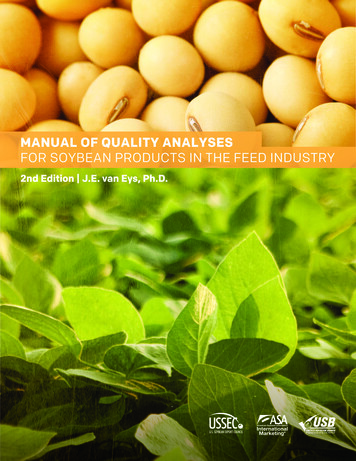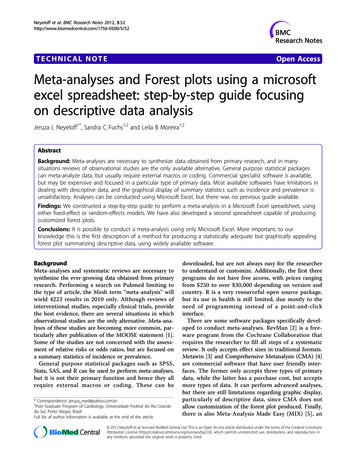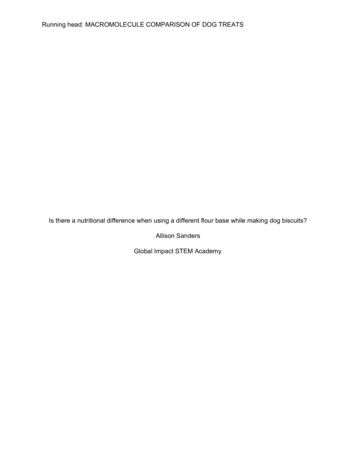
Transcription
MANUAL OF SOY QUALITY ANALYSESThe term “quality” is widely used by the feed industry and also by all organizations involved in animalproduction. This second edition of the “Manual of Soy Quality Analyses for Soybean Products inthe Feed Industry” provides up-to-date, reliable and easy to search information to quality controllaboratories, universities, research centers, animal and human nutritionists, soybean traders andorganizations and individuals with an interest in the quality analyses of soybeans, soybean mealand related products.In today’s world, the quality of soybeans and soybean meal must be measured in an accurate, fastand economical way. The U.S. Soybean Export Council (ASA-IM) proudly presents Dr. Jan van Eys’well-organized, thorough compilation. Dr. van Eys has many years of experience in animal nutrition,and is highly recognized and respected internationally.The various sections of the document provide the most up-to-date information we have, and ourintention is to continue updating it as new information becomes available to the scientific andtrade community.Our sincere gratitude to all the people involved in the preparation of this manual.We hope you find this reference manual and CD useful tools for your quality and soy library.Miguel E. Escobar, DVMGlobal Director Animal UtilizationU.S. SOYBEAN EXPORT COUNCILLetter
MANUAL of QUALITY ANALYSESfor SOYBEAN PRODUCTS in the FEED INDUSTRY.2nd Edition.J.E. van Eys, Ph.D.GANS Inc., 24 Av. de la Guillemote, 78112 Fourqueux, France ; jvaneys@gmail.comCONTENTSA. Introduction1.1.List of AbbreviationsB. Soybeans, soybean products and production processesC. Definitions and applications of soybeans and soy productsD. Chemical and nutritional composition of soybean productsE. Official standards of some soybean productsF. Sampling soy productsG. Physical evaluation and equipmentH. Chemical analyses8.1.Moisture8.2.Ash8.3.Protein8.4.Protein quality8.4.1. Urease Index8.4.2. KOH protein solubility8.4.3. Protein Dispersibility Index (PDI)8.4.4. Protein quality in ruminants8.4.4.1.In situ technique8.4.4.2.In vitro technique8.5.Amino acids8.6.Crude fiber (CF)8.7.Neutral Detergent Fiber (NDF)8.8.Acid Detergent Fiber (ADF)8.9.Lignin8.9.1. Klason lignin8.9.2. Permanganate lignin8.10.Starch8.10.1. Polarimetric starch determination8.10.2. Enzymatic or colorimetric starch determination8.11.Non Starch Polysaccharides (NSP) and Monosaccharides8.12.Ether Extracts (EE)8.13.Lipid quality8.13.1. Moisture8.13.2. Insoluble impurities8.13.3. Unsaponifiable matter8.13.4. Iodine value (IV)8.13.5. Acid value8.13.6. Lipid oxidation8.13.6.1.Peroxide value8.13.6.2.Thiobarbituric acid 13H-14H-15H-16H-17H-20H-22H-2
8.13.6.3.Anisidine value8.13.6.4.Lipid stability tests8.13.6.4.1.AOM (Active Oxygen Method)8.13.6.4.2.OSI (Oil Stability Index)8.13.7. Fatty acid profile8.14.Minerals8.14.1. Calcium8.14.2. Phosphorus8.14.3. Sodium chloride8.15. Iso-flavones8.16. Anti-nutritional factors8.16.1.Trypsin inhibitors8.16.2.Soy antigens8.16.3.Lectins8.17.Mycotoxins; rapid Genetically Modified Organisms (GMO)I. NIR analysesJ. Full fat soybeans (FFSB)K. Data management10.1. Sample statistics10.2. Quality indicators10.3. Significance of parameter estimates10.4. Control charts10.5. Follow-up and application of analytical J-1K-1K-1K-4K-6K-8K-10
LIST OF FIGURES AND TABLES.Figures1Schematic representation of the manufacturing of soybean products.2 Protein disappearance from soybean meal and curve peeling process3 Auto-oxidation of linolenic acid.4 Example of a density curve describing a normal distribution.5 Histogram of the data based on seven intervals.6 Definition of accuracy versus precision.7 Control chart for protein content (% of DM) analyses in soybean meal samples.Tables1Description and classification of soybean products.2 Application of soybean products.3 Composition of some soy protein ingredients used in animal feeds.4 Analytical characteristics of common types of soy protein products.5 U.S. grades and grade requirements for soybeans.6 4QFDJGJDBUJPOT GPS 4PMWFOU &YUSBDUFE BOE %FIVMMFE 4PZCFBO .FBMT 7 Recommended additional specifications for soybean meal.8 Standards for edible crude de-gummed soybean oil and vegetable oilsin animal feed.9 Effect of heat processing on amino acid digestibility of raw soybeans in poultry.10 Effect of heat-processing soybean meals on amino acid concentration11 Comparison of three laboratory techniques to determine under-processing orcorrect processing of commercial soybean meals.12 Effect of autoclaving soybean meal on chick performance (1-18 days), KOH proteinsolubility and urease activity.13 A brief description of available methods to determine protein quality ofsoybean meal.14 Optical rotation of various pure starch sources.15 Solutions to prepare standard curve for colorimetric starch determination.16 Dilution scheme for the trypsin inhibitor activity determination by theISO (2001) method.17 ELISA formats used for analysis of soy globulins.18 Anti-nutritional factor contents in various soy products.19 Extrusion temperature of FFSB, trypsin inhibitors, and performanceof broiler chickens .20 Extrusion temperatures of FFSB, in vivo digestible amino acid coefficients, andKOH protein solubility.21 Apparent ileal amino acid digestibility coefficients in broiler chickens fed FFSBcontaining different concentrations of TIA.22 Common notation of parameters and parameter estimates.23 Protein content of soybean meal: calculation steps to determine the meanand variance.24 Typical ranges and acceptable coefficients of variation for proximate analysisin feedstuffs.25 Error types in hypothesis testing.26 Protein content (% of DM) in soybean meal K-2K-3K-6K-7K-9
MANUAL OF SOY QUALITY ANALYSESA. INTRODUCTION.The use of soybean products in the feed and food industry has increased steadily over the pastdecades.Of the total world production of soybeans, more than 90% is directly used for animalconsumption. The overwhelming majority is used in animal feed in the form of various types ofsoybean meals or specialty soy products. The current world production of soybean meal is estimatedto be in excess of 182 million metric tons which amounts to approximately 69% of all the major proteinmeals (USDA, 2011). With global compound feed estimates at well over 700 million Metric Tons Best,(2010) soybean meals represent the dominant source of protein in animal diets. However, total useand importance of soybeans or soybean products is likely to be higher than indicated by majorstatistics as a plethora of different soybean products are entering the feed and food chain. Thisdominant position of soybeans and their products is no doubt associated with their high qualityespecially with respect to protein and amino acid profile. Following proper treatment or extraction,digestibility of the protein fraction is high and the amino acid profile provides a close match whencombined with cereals to meet animal requirements. Nevertheless, in their untreated form, soybeanscontain a number of factors that have the potential to diminish their nutritive value - to the point ofdecreasing animal performance and health (Liener, 2000). A treatment of soybeans to eliminatethese anti nutritional factors (ANF) is thus necessary especially in the case of monogastric diets.These treatments, combined with varietal differences in the production process of soybean meals orother products lead to potentially large variations in quality.While basic standard specifications for soybean meals have been established (NOPA, 2011) noofficial specifications exist for other soy products that are routinely used in the feed industry.Furthermore the NOPA specifications only refer to four chemical characteristics. Current evaluationsof soy products by industry nutritionists and formulators are based on a much larger array of testsallowing a more accurate evaluation of the nutritive value of the different products. However, underpractical conditions of feed production the choice of tests differ greatly among producers and feedcompounders and not all tests are applied on a regular basis (West, 2002). It is most likely that in thefuture more analyses of greater complexity will be needed. Developments in the technologicalmodification of soy bean products, along with a better understanding of the effects on performanceand health of relatively unknown compounds, such as isoflavones, will add value to soy products.Accurate analysis to measure the effects of new treatments and the relatively unexploredcompounds will be of great importance.In order for results of quality tests to have real value and to be comparable between producers it isimportant that tests are standardized in method as well as equipment. This standardization isbecoming increasingly important as trade in soybean products grows more global and competitionamongst suppliers increases. Identity preservation and traceability associated with detailed qualitycharacterization are issues of major importance in the (future) trade of soy products. Accurate andconsistent quality procedures and analyses along with precise descriptions of the product arenecessary. These tests must be reproducible at different levels of the supply chain. Furthermore, theincreasing demands of the implemented quality systems (HACCP, ISO, FAMI-QS, or GMP) will dictatethe establishment of more detailed quality procedures and a larger analytical capacity. For theinformation that is generated at the various production stages to be consistent and comparable it isimportant that a single reference is available.This quality manual intends to provide clear directives and explanations for the quality analysisneeded at all stages of the soy protein supply chain in the feed industry. The objective is to supplyinformation that is applicable at all levels of operation, from the crusher to the compounder and fromthe quality operator in the plant to the nutritionist. Applications of the methods and analysespresented will enhance the value of soy products through improved knowledge and applicationresulting in improved performance and health.U.S. SOYBEAN EXPORT COUNCILA-1
MANUAL OF SOY QUALITY ANALYSESACRONYMS AND ABBREVIATIONS:AA – Amino acidsAAFCO - Association of American FeedControl OfficialsADF - Acid Detergent FiberADL - Acid Detergent Lignin (Klason Lignin)ANF - Anti-nutritional factorsAOM - ActiveOxygen MethodaP – Available PhosphorusBAPNA - α-Benzoyl D L-Arginine p-NitroanilideBBI - Bowman-Birk IinhibitorCa – CalciumCE - Capillary ElectrophoresisCF – Crude FiberCFIA - Canadian Food Inspection AgencyCl – ChlorideCP – Crude ProteinD – BiasDAA- Digestible Amino AcidsDON – DeoxynivalenolEE – Ether extract (oil and fats)ELISA - Enzyme-Linked Immuno-SorbentAssayFA - Fatty acidFA – Fatty AcidFFSB - Full Fat SoybeansFLIA - Functional LectinsGC - Gas ChromatographyGLC - Gas liquid chromatographyGMO – Genetically Modified OrganismHPLC - High Performance LiquidChromatographyI.V. - Iodine valueIFN - International Feed Name and NumberKOH – Potassium HydroxideKTI - Kunitz Trypsin InhibitorMLR - Multiple Linear RegressionU.S. SOYBEAN EXPORT COUNCILME – Metabolizable EnergyMT – Metric TonsMUI - Moisture, Unsaponifiables, InsolublesNa – SodiumNDF - Neutral Detergent FiberNFE - Nitrogen Free ExtractNIR - Near Infrared Reflectance SpectroscopynPP – Non-Phytin PhosphorusNSI - Nitrogen Solubility IndexNSP - Non Starch PolysaccharidesOSI - Oil Stability IndexOSI – Oil Stability IndexP – PhosphorusPP- Phytin PhosphorusPCA - Principal Component AnalysisPCR - Polymerase Chain Reaction (test)PDI – Protein Dispersibility IndexPLS - Partial Least SquaresQC – Quality ControlR2 - Regression CoefficientSBM - Soybean MealSE – Standard ErrorSEP - Standard error of PredictionSPC - Soy Protein ConcentratesSPI - Soy Protein IsolatesT.I. – Trypsin InhibitorTBA - Thiobarbituric AcidTBA - Thiobarbituric AcidTIA - Trypsin Inhibitor ActivityTIU - trypsin Inhibitor UnitsTLC - Thin-layer ChromatographyTLC - Thin-layer ChromatographyTris – (Hydroxyl-methyl)-Amino-MethaneU.A. – Urease ActivityU.I. – Urease IndexA-2
MANUAL OF SOY QUALITY ANALYSESB. SOYBEANS, SOYBEAN PRODUCTS AND PRODUCTION PROCESSES.A large number of soybean varieties exist, producing soybeans that vary greatly in shape andcolor. For the complete range of soybeans, shapes vary from flat to spherical and colors range fromyellow to green, brown and black. Modern varieties, mainly grown for their oil content, are generallyspherical in shape with yellow or green as the accepted seed coats. These characteristics logically willaffect many of the soybean products obtained from these beans. Official limits have been set on theminimal size requirements for the beans (see below) but generally soybeans grown for industrialpurposes will weigh between 18 – 20 g per 100 beans.The soybean consists of two cotyledons which represent approximately 90% of the weight, a seedcoat or hull (8% of weight), and two much smaller and lighter structures the hypoctyl and the plumule.The cotyledons contain the proteins and lipids (oils) that constitute the main nutritional componentsof the soybean products obtained from soybeans. They are also the main storage area for thecarbohydrates and various other components of importance, most notably the enzymes(lipoxygenase, urease) and the anti-nutritional factors (ANF).The various soybean products are obtained through the separation or extraction of the differentcomponents of the soybean. A large array of different manufacturing processes is applied to obtainthe many soy products used in animal and human nutrition (Berk, 1992). Figure 1 provides a schematicrepresentation of the transformation from soybean into the various products.In the “crushing” process of soybeans, which includes a series of preparatory operations, crude oilis obtained as a major product. The crude oil is refined and separated into lecithin and refined oil usedin human as well as animal nutrition; especially in young animal diets. The soybean meals, which on avolume basis are the most important products obtained from soybeans, have the de-fatted flakes asan intermediary product that requires further treatment. Two main processes are used to extract theoil and obtain the de-fatted flakes: the expeller process (mechanical extraction of the oil by a screwpress) or solvent extraction where non-polar solvents (commonly hexane and hexane isomers) areused to extract the oil. Solvent extraction is the most efficient and widely used process at present. Inthe case of solvent extraction, the flakes are de-solventized. All flakes are toasted in order toeliminate the heat-labile anti nutritional factors. Sometimes the hulls obtained in the preparatorysteps are added back to the toasted flakes. This is done in variable degrees resulting in soybeanmeals with variable levels of fiber and crude protein. When no hulls are added, the high protein mealsare obtained. These are the meals used predominantly in poultry diets and aquaculture diets.Flash de-solventization or heat vacuum drying of the de-fatted flakes produces the white flakesthat are higher in protein quality (solubility) and do not have the undesirable darker color. Through aseries of different extraction and precipitation processes, soy protein isolates (SPI) or soy proteinconcentrates (SPC) are produced. Whereas SPI production is fairly standardized, different methods ofextraction are used to obtain the SPC resulting in slightly different compositional characteristics. SPCbut also the white flakes can be further elaborated (grinding, texturizing, separation on the basis ofmolecular weight) to obtain a large array of products used in human nutrition. SPI and SPC are used inanimal nutrition but are limited to specialty diets due to the relatively high cost. The use of theseingredients in animal diets is mainly as a replacement of high quality protein sources such as animalor milk proteins or as a replacement of fishmeal in aquaculture diets.U.S. SOYBEAN EXPORT COUNCILB-1
MANUAL OF SOY QUALITY ANALYSES1Figure 1. Schematic representation of the manufacturing of soybean products .* only in the case of solvent extraction.1Boxes with regular script are processes; boxes with italics: intermediary products; in blue anditalics are final soy products.U.S. SOYBEAN EXPORT COUNCILB-2
MANUAL OF SOY QUALITY ANALYSESC. DEFINITION AND APPLICATION OF SOYBEANS AND SOY PRODUCTS.The number of soy products currently being used in the feed industry is large, and an exhaustivereview is hardly possible. Recent years have seen a dramatic expansion of specialty products basedon soybeans. Classical, commodity products such as raw soybeans and soybean meals are relativelywell defined with thorough descriptions and specifications. This is not necessarily the case for someof the recent modifications or adaptations of these products (i.e. Rumen-protected soybean meal) orfurther elaborated products (i.e. soy concentrates). These evolved, value-added products may differsignificantly among producers, with each producer applying proprietary knowledge and specializedtreatments. Typically, value–added products must be evaluated on the basis of the entity thatproduces them taking into account the guarantees provided by the manufacturer or distributor.Consistent analysis of these producer-specific products allows classification and the building of anaccurate database along with improved confidence about the product. This increased level ofknowledge will allow an analysis schedule of decreased intensity and drive increased inclusion ratesin diets.Commodities as well as the value-added products can be classified in a specific class or groupof products for which a sufficiently specific description can be developed. For an efficient and correctuse - as well as a meaningful interpretation of analytical results - a precise and generally agreed upondefinition of the product is needed. Trading, purchasing, formulation, and the entire operation of feedmanufacturing depend on the precise referencing of a raw material and the consistent use of thecorrect name and description. Also the quality control mechanisms that have been introduced in thefeed industry require a precise description and classification for all ingredients.Although many databases and ingredient tables have their own classification system, the mostwidely recognized system is probably the IFN system (International Feed Name and number) (INFIC,1980). In this system, ingredients have been divided into eight fairly arbitrary feed classes on the basisof their composition and use (NRC, 1982). The system is widely used in the UK, the US and in Canadianfeed composition tables but less so in other countries.In the IFN system, ingredients are assigned a six digit code with the first digits denoting theInternational Feed Class Number. With the exception of soybean hay, soybean hulls (class 1), lecithin,soybean mill run and soybean mill feed (class 4), soy products listed in table 1 fall in the class ofprotein supplements (5) defined as products that contain more than 20 % crude protein on a drymatter basis. The five digits following the class number is the link between the INF and chemical andbiological data in the USA databank (NRC, 1982). The number appears generally on official USingredient specifications and, although the system may not be used by all feed producers ormanufacturers, it provides an easy and systematic reference for quality systems and formulationpurposes.A brief and general description is available for many soy products. This description has theadvantage of providing information that is not generally captured in compositional tables. It alsoprovides for a general appreciation of the origin and quality and thus the potential applications oruses in a feed. Although these definitions might differ slightly between different sources, they are ingeneral sufficiently similar to use them interchangeable. The Association of American Feed ControlOfficials (AAFCO) publishes at regular intervals reference specifications for soybean products(AAFCO, 2006). These definitions have been used as a basis for the specifications listed in Table 1.U.S. SOYBEAN EXPORT COUNCILC-1
MANUAL OF SOY QUALITY ANALYSESTable 1. Description and classification of soybean products.1.2.3.4.5.6.7.8.9.10.11.12.13.1Condensed Soybean Solubles is the product obtained by washing soy flour or soybean flakeswith water and acid at a pH of 4.2-4.6. The wash water is then concentrated to a solid contentof not less than 60%. IFN 5-09-344.Dried Soybean Solubles is the product resulting from the washing of soy flour or soybeanflakes with water and acid; water, alkali and acid; or water and alcohol. The wash water is thendried. IFN 5-16-733.Full Fat Soybeans, Extruded (AAFCO: Ground Extruded Whole Soybeans) is the meal productresulting from extrusion by friction heat and/or steam of whole soybeans without removingany of the component parts. It must be sold according to its crude protein, fat and fibercontent. IFN 5-14-005.Full Fat Soybeans, Raw (AAFCO: Ground Soybeans) are obtained by grinding wholesoybeans without cooking or removing any of the oil. IFN 5-04 -596.Full Fat Soybeans, Roasted (AAFCO: Heat Processed Soybeans) is the product resultingfrom heating whole soybeans without removing any of the component parts. It may beground, pelleted, flaked or powdered. It must be sold according to its crude protein content.Maybe required to be labeled with guarantees for maximum crude fat, maximumcrude fiber and maximum moisture (CFIA 2003). IFN 5-04-597.Ground Soybean Hay is the ground soybean plants including the leaves and beans. It must bereasonably free of other crop plants and weeds and must contain no more 33% crude fiber.IFN 1-04-559.Kibbled Soybean Meal is the product obtained by cooking ground solvent extracted soybeanmeal, under pressure and extruding from an expeller or other mechanical pressure device. Itmust be designated and sold according to its protein content and shall contain no more than7% crude fiber. IFN 5-09-343.Protein Modified Soybean is a product that has been processed to primarily modify thenatural protein structure by utilizing acids, alkalis or other chemicals and without removingsignificant amounts of any nutrient constituent. The defined name under section 84 of theapplicable soybean product so modified shall be declared in the product name. IFN 5-26-010.Soy Flour is the finely powdered material resulting from the screened and graded product afterremoval of most of the oil from selected sound cleaned and dehulled soybeans by amechanical or solvent extraction process. It must contain no more than 4.0% crude fiber.Some organizations also require labeling guarantees for minimum crude proteinand maximum crude fat and moisture. IFN 5-12-177.Soy Grits is the granular material resulting from the screened and graded product after removalof most of the oil from selected, sound, clean and dehulled soybeans by a mechanical orsolvent extraction process. It must contain no more than 4% crude fiber. Soybean gritsmechanical extracted: IFN 5-12-176. Soybean grits solvent extracted: IFN 5-04-592Soy Lecithin or Soy Phosphate is the mixed phosphatide product obtained from soybean oilby a degumming process. It contains lecithin, cephalin and inositol phosphatides, togetherwith glycerides of soybean oil and traces of tocopherols, glucosides and pigments. It must bedesignated and sold according to conventional descriptive grades with respect toconsistence and bleaching. IFN 4-04-562.Soy Protein Concentrate is prepared from high quality, sound, dehulled soybean seeds byremoving most of the oil and water soluble non-protein constituents from selected, sound,cleaned, dehulled soybeans (CFIA 2003) and must contain not less than 65% protein on amoisture-free basis. It shall be labeled with guarantees for minimum crude protein,maximum crude fat, maximum crude fiber, maximum ash and maximummoisture. IFN 5-32-183.Soy Protein Isolate is the major proteinaceous fraction of soybeans prepared from dehulledsoybeans by removing the majority of non-protein components, and contains not less thanU.S. SOYBEAN EXPORT COUNCILC-2
MANUAL OF SOY QUALITY ANALYSES14.15.16.17.18.19.20.21.22.23.90% protein on a moisture-free basis. The CFIA (2003) adds that the original material mustconsist of selected, sound, cleaned, dehulled soybeans and that it shall be labeled withguarantees for minimum crude protein (90%), maximum ash and maximummoisture. IFN Number 5-08-038 (CFIA lists this product with the IFN Number 5-24-811.Soybean Feed, Solvent Extracted is the product remaining after the partial removal ofprotein and nitrogen free extract from dehulled solvent extracted soybean flakes. IFN 5-04613.Soybean Flour Solvent Extracted (or Soy flour) is the finely powdered material resultingfrom the screened and graded product after removal of most of the oil from dehulledsoybeans by a solvent extraction process. It shall contain less than 4 percent crude fiber. Itshall be labeled with guarantees for minimum crude protein, maximum crudefat, maximum crude fiber and maximum moisture. IFN 5-04-593.Soybean Hulls consist primarily of the outer covering of the soybean. IFN-1-04-560.Soybean Meal, Mechanical Extracted is the product obtained by grinding the cake or chipswhich remain after removal of most of the oil from soybeans by a mechanical extractionprocess. It must contain no more than 7% crude fiber. It may contain an inert, non-toxicconditioning agent either nutritive or non-nutritive or any combination thereof, to reducecaking and improve flowability in an amount not to exceed that necessary to accomplish itsintended effect and in no-case exceed 0.5%. The name of the conditioning agent must beshown as an added ingredient. IFN 5-04-600.Soybean Meal, Dehulled, Solvent-Extracted is obtained by grinding the flakes remainingafter removal of most of the oil from dehulled soybeans by a solvent extraction process. Itmust contain no more than 3.3% crude fiber. It may contain an inert non-toxic conditioningagent either nutritive or non-nutritive or any combination thereof, to reduce caking andimprove flowability in an amount not to exceed that necessary to accomplish its intendedeffect and in no-case to exceed 0.5%. The name of the conditioning agent must be shown asan added ingredient. IFN 5-04-612. It may also be required to be labeled withguarantees for minimum crude protein, maximum crude fat and maxim ummoisture(CFIA 2003).Soybean Meal, Solvent-Extracted, is the product obtained by grinding the flakes whichremain after removal of most of the oil from soybeans by a solvent extraction process. It mustcontain no more than 7% crude fiber. It may contain an inert, non-toxic conditioning agenteither nutritive or non-nutritive and any combination thereof, to reduce caking and improveflowability in an amount not to exceed that necessary to accomplish its intended effect and inno-case exceed 0.5%. It shall contain less than 7 percent crude fiber. The CFIA (2003)specifies that it shall be labeled with guarantees for minimum crude protein,maximum crude fat and maximum moisture. IFN 5-04-604.Soybean Mill Feed is composed of soybean hulls and the offal from the tail of the mill whichresults from the manufacture of soy grits or flour. It must contain not less than 13% crudeprotein and not more than 32% crude fiber. IFN 4-04-594.Soybean Mill Run is composed of soybean hulls and such bean meats that adhere to the hullswhich results from normal milling operations in the production of dehulled soybean meal. Itmust contain not less than 11% crude protein and not more than 35% crude fiber. IFN 4-04595.Soybean Oil consists of the oil from soybean seeds that are commonly processed for ediblepurposes. It consists predominantly of glyceride esters of fatty acids. If an antioxidant(s) isused, the common name or names shall be indicated on the label. It shall be labeled withguarantees for maximum moisture, maximum insoluble matter, maximum unsaponifiable matter and maximum free fatty acids. IFN 4-07-983.Soyflour Chemically and Physically modified is the product resulting from treating soyflour by chemical and physical (heat and pressure) means. It shall be labeled withguarantees for minimum crude protein, maximum crude fat, maximum crudefiber and maximum moisture. IFN 5-19-651.U.S. SOYBEAN EXPORT COUNCILC-3
MANUAL OF SOY QUALITY ANALYSES1(In alphabetical order; adapted from the AAFCO Official Publication 2006 and the CFIA. 2003).The list in Table 1 gives an impression of the large diversity of soy products and different methodsof producing them. Although it only represents the major soy products produced, it provides a briefdescription of how the product is obtained and for some products a compositional reference point.The common name and IFN is provided which allows for a consistent and non-equivocal use ofingredients, important in quality systems. The description gives an adequate back ground of theproducts for trading and classification purposes, references in quality systems and productionpurposes. It is sufficiently precise to provide clear reference points for product definition and contractagreements but general enough to cover a substantial variation in composition and productionprocesses. For proper use of an ingredient, additional analytical data should complement theinformation provided in the description. However, for analytical purposes the descriptions providegeneral back ground information as to what can be expected and how analysis should be carried outor what results may be expected. When considering
17 ELISA formats used for analysis of soy globulins. H-38 18 Anti-nutritional factor contents in various soy products. H-39 19 Extrusion temperature of FFSB, trypsin inhibitors, and performance of broiler chickens . J-2 20 Extrusion temperatures of FFSB, in vivo digestible amino ac










